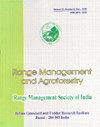印度旁遮普省中部灌溉条件下不同播种环境下饲料珍珠粟品种的生产潜力、品质及热利用
IF 0.8
4区 农林科学
Q3 AGRONOMY
引用次数: 0
摘要
本试验于2019年和2020年连续两年在印度卢迪亚纳旁遮普省农业大学进行,研究珍珠谷子和珍珠谷子品种播期对青饲料产量、品质和作物热利用的影响。田间试验采用分割小区设计,主小区7个播期(4月1日、4月15日、5月1日、6月1日、6月15日、7月1日和7月15日),子小区2个珍珠粟品种(PCB 165和FBC 16) 3个重复。6月1日播种青饲料产量最高(69.3 t/ hm2),这可能与植株高度和分蘖数最大有关。6月1日播种作物的干物质和粗蛋白质产量最高,分别为15.0 t/ha和0.95 t/ha。提前和延迟播种均显著降低青料和干物质产量。5月1日播种的作物需要最大生长度数,50%花期的光热和日光热单位,早播和晚播均显著降低了这些农业气候指标。在不同的播期,PCB 165的青饲料和干物质产量比FBC 16分别提高了11.9%和12.4%,这是由于50%花期生长度日数、光热和日光热单位积累量更高。互作效应表明,5月1日、6月1日和6月15日播种的PCB 165绿饲料产量显著高于FBC 16,其他播期差异不大且不显著。本文章由计算机程序翻译,如有差异,请以英文原文为准。
Production potential, quality and thermal utilization of fodder pearl millet varieties under different sowing environments in irrigated conditions of central Punjab in India
An experiment was conducted at Punjab Agricultural University, Ludhiana, India during two consecutive years i.e., 2019 and 2020 to study the effect of dates of sowing and pearl millet varieties on productivity and quality of green fodder and thermal utilization by the crop. The field experiment was laid-out in a split plot design with seven dates of sowing (1st April, 15th April, 1st May, 1st June, 15th June, 1st July and 15th July) in main plots and two varieties of pearl millet (PCB 165 and FBC 16) in sub plots with three replicates. Significantly highest green fodder yield (69.3 t/ha) was obtained with 1st June sowing which was probably on account of maximum plant height and number of tillers. The 1st June sown crop also recorded significantly highest dry matter and crude protein yield of 15.0 t/ha and 0.95 t/ha, respectively. Both advanced and delayed sowings recorded significant reduction in green fodder and dry matter yield. The crop sown on 1st May required maximum growing degree days, photo-thermal and helio thermal units at 50% flowering stage and sowing done early as well as late recorded significant reduction in these agro-climatic indices. Across different dates of sowing, PCB 165 registered an increase of 11.9 and 12.4% in green fodder and dry matter yields, respectively over FBC 16 due to higher accumulation of growing degree days, photo-thermal and helio thermal units for 50% flowering stage. The interaction effect showed that PCB 165 sown on 1st May, 1st and 15th June recorded significantly more green fodder yield over FBC 16, while the differences were narrow and non-significant at other dates of sowing.
求助全文
通过发布文献求助,成功后即可免费获取论文全文。
去求助
来源期刊

Range Management and Agroforestry
AGRONOMY-
CiteScore
1.50
自引率
62.50%
发文量
25
审稿时长
>12 weeks
期刊介绍:
The Society has been established with the following objectives:
1. To advance the cause of research activity in all aspects of rangelands and to encourage and promote the studies on rangeland, wasteland ecosystems and agroforestry.
2. To provide facilities for seminars and conferences to rangeland researchers, development workers and farmers and to encourage close cooperation with organizations having related aims and interests.
3. To disseminate the knowledge of scientific agriculture and technology for forage and rangeland production, improvement and management.
 求助内容:
求助内容: 应助结果提醒方式:
应助结果提醒方式:


